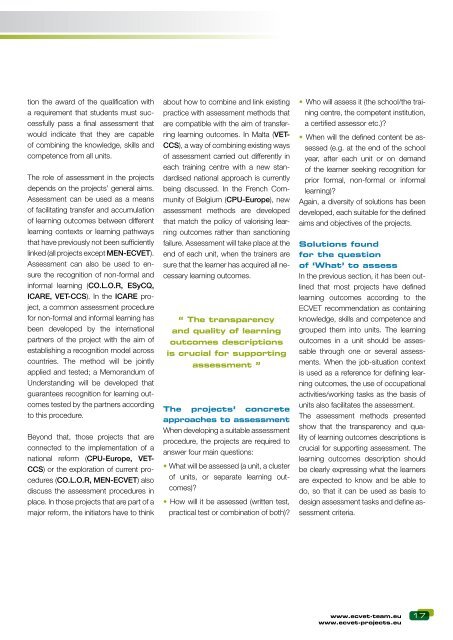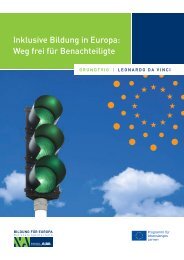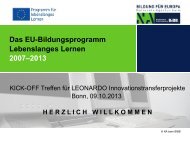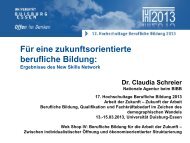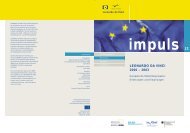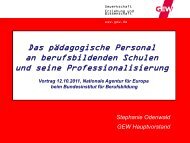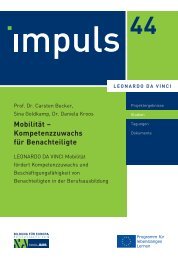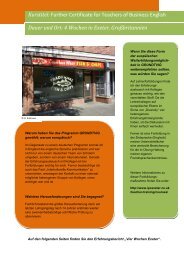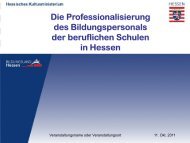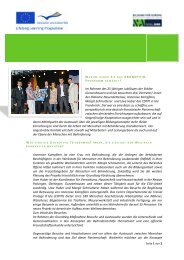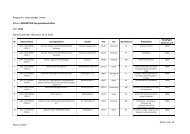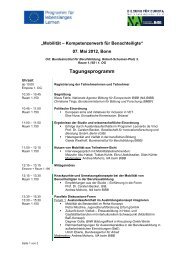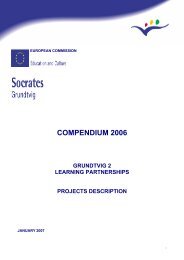Create successful ePaper yourself
Turn your PDF publications into a flip-book with our unique Google optimized e-Paper software.
tion the award of the qualification with<br />
a requirement that students must successfully<br />
pass a final assessment that<br />
would indicate that they are capable<br />
of combining the knowledge, skills and<br />
competence from all units.<br />
The role of assessment in the projects<br />
depends on the projects’ general aims.<br />
Assessment can be used as a means<br />
of facilitating transfer and accumulation<br />
of learning outcomes between different<br />
learning contexts or learning pathways<br />
that have previously not been sufficiently<br />
linked (all projects except MEN-ECVET).<br />
Assessment can also be used to ensure<br />
the recognition of non-formal and<br />
informal learning (CO.L.O.R, ESyCQ,<br />
ICARE, VET-CCS). In the ICARE project,<br />
a common assessment procedure<br />
for non-formal and informal learning has<br />
been developed by the international<br />
partners of the project with the aim of<br />
establishing a recognition model across<br />
countries. The method will be jointly<br />
applied and tested; a Memorandum of<br />
Understanding will be developed that<br />
guarantees recognition for learning outcomes<br />
tested by the partners according<br />
to this procedure.<br />
Beyond that, those projects that are<br />
connected to the implementation of a<br />
national reform (CPU-Europe, VET-<br />
CCS) or the exploration of current procedures<br />
(CO.L.O.R, MEN-ECVET) also<br />
discuss the assessment procedures in<br />
place. In those projects that are part of a<br />
major reform, the initiators have to think<br />
about how to combine and link existing<br />
practice with assessment methods that<br />
are compatible with the aim of transferring<br />
learning outcomes. In Malta (VET-<br />
CCS), a way of combining existing ways<br />
of assessment carried out differently in<br />
each training centre with a new standardised<br />
national approach is currently<br />
being discussed. In the French Community<br />
of Belgium (CPU-Europe), new<br />
assessment methods are developed<br />
that match the policy of valorising learning<br />
outcomes rather than sanctioning<br />
failure. Assessment will take place at the<br />
end of each unit, when the trainers are<br />
sure that the learner has acquired all necessary<br />
learning outcomes.<br />
“ The transparency<br />
and quality of learning<br />
outcomes descriptions<br />
is crucial for supporting<br />
assessment ”<br />
The projects’ concrete<br />
approaches to assessment<br />
When developing a suitable assessment<br />
procedure, the projects are required to<br />
answer four main questions:<br />
• What will be assessed (a unit, a cluster<br />
of units, or separate learning outcomes)?<br />
• How will it be assessed (written test,<br />
practical test or combination of both)?<br />
• Who will assess it (the school/the training<br />
centre, the competent institution,<br />
a certified assessor etc.)?<br />
• When will the defined content be assessed<br />
(e.g. at the end of the school<br />
year, after each unit or on demand<br />
of the learner seeking recognition for<br />
prior formal, non-formal or informal<br />
learning)?<br />
Again, a diversity of solutions has been<br />
developed, each suitable for the defined<br />
aims and objectives of the projects.<br />
Solutions found<br />
for the question<br />
of ‘What’ to assess<br />
In the previous section, it has been outlined<br />
that most projects have defined<br />
learning outcomes according to the<br />
ECVET recommendation as containing<br />
knowledge, skills and competence and<br />
grouped them into units. The learning<br />
outcomes in a unit should be assessable<br />
through one or several assessments.<br />
When the job-situation context<br />
is used as a reference for defining learning<br />
outcomes, the use of occupational<br />
activities/working tasks as the basis of<br />
units also facilitates the assessment.<br />
The assessment methods presented<br />
show that the transparency and quality<br />
of learning outcomes descriptions is<br />
crucial for supporting assessment. The<br />
learning outcomes description should<br />
be clearly expressing what the learners<br />
are expected to know and be able to<br />
do, so that it can be used as basis to<br />
design assessment tasks and define assessment<br />
criteria.<br />
<strong>www</strong>.<strong>ecvet</strong>-<strong>team</strong>.<strong>eu</strong> 17<br />
<strong>www</strong>.<strong>ecvet</strong>-projects.<strong>eu</strong>


